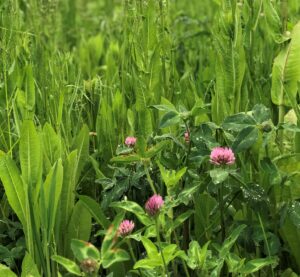 The most valuable asset to any farmer is their soil. Cover cropping can help speed up your soils recovery and health. Investing in your soil through cover cropping can increase yields, cut costs of fertilizer and herbicides, and create living soil for future generations.
The most valuable asset to any farmer is their soil. Cover cropping can help speed up your soils recovery and health. Investing in your soil through cover cropping can increase yields, cut costs of fertilizer and herbicides, and create living soil for future generations.
There are a multitude of benefits cover cropping can offer your soil, we’ve picked a few to highlight.
Cover Crops Conserve Soil Moisture
Starting with the roots, cover crops increase rain infiltration by loosening soil compaction and creating new pathways for water to reach deeper into the ground. This decreases evaporation, keeps the soil cooler, and reduces crop heat stress, which is incredibly beneficial during drought years. The improved soil structure and stability can improve its capacity to withstand equipment and animals.
Cover Crops Protect Water Quality
Cover crops can reduce sediment losses from erosion by up to 20.8 tons per acre on conventional-till fields and up to 1.2 tons per acre on no-till fields. By reducing the loss of nutrients, pesticides, and sediment, cover crops can protect local water quality. Both legumes and grasses trap nitrogen (N), reducing run off that could travel into waterways that could cause imbalances. (Source)
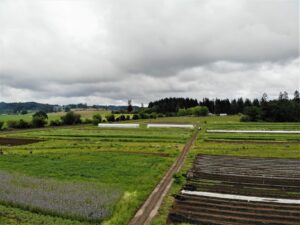
Cover Crops Reduce Weeds
Seeding a cover crop that establishes quickly and produces large amounts of biomass will use soil resources that would otherwise go to weed germination. This can reduce the need for herbicides and other pesticides, and encourage beneficial insects and microbial life. Terminating the cover crop late or leaving residue in the field after termination provides a physical blanket of ground cover that shades out weeds and hinders germination.
Cover Crops Can Cut Fertilizer Costs
Over time, cover crops can reduce the need for fertilizer. Both legumes and grasses trap nitrogen in the soil and keep it from leaching. Legumes also convert N from the atmosphere into soil nitrogen, but have slower growth. The building up of organic matter in soil reduces the need for applying additional nitrogen.
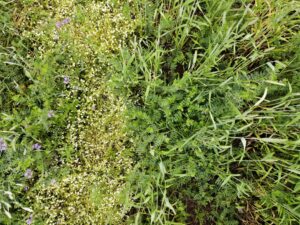
Cover Crops Regenerate Soil and Increase Yields
Cover crops speed infiltration of surface water, relieve soil compaction, add organic matter, and enhance nutrient cycling. According to the 2017 Sustainable Agriculture Research & Education cover crop survey, among 1,770 farmers, 54% saw soil health improvements in the first year of cover cropping. Yield gains were seen following cover crops in corn, soybeans, and wheat. Corn saw 1.3% increase per acre, soybeans saw 3.8% increase per acre. (Source)
Cover Crops Control Soil Erosion
Quick growing cover crops hold soil in place, protecting erosion of the ground from heavy rains. Above ground, it will help protect your soil from strong winds and the impact of raindrops. Rooting into the soil (bio strip-tilling) increases water filtration, reducing the amount of soil being carried away.
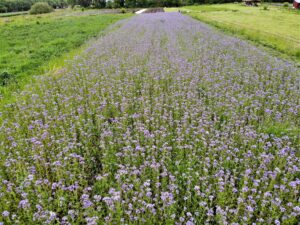
Cover Crops Can Be Used for Forage
Cover crops are typically grown during times when livestock need supplemental feed, lengthening the grazing season. Common blends for forage cover crops include grains, legumes, and brassicas. Diverse mixes can improve soil health, holding soil, and provide an economical forage option. Grazing can begin after cover crops grow six to eight inches tall for the grasses, and 10 inches for legumes and brassicas. Brassicas are deeply rooted and grow well in dry conditions.
When to plant – General guideline:
FALL: Plant after cash crop harvest, at least six weeks before you expect the first hard frost of the season. Cereal grains, especially rye, are an exception and can be planted as late as the first frost of the winter. Depending on your field goals, you can choose an annual or perennial seed.
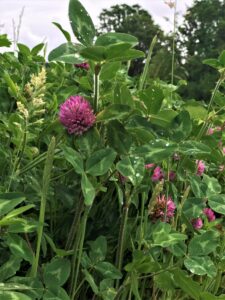 SUMMER: If you have fallow period between early and late planted crops on the same field, you may consider planting a quick-growing summer annual such as buckwheat, sorghum-sudangrass, or warm-season legume such as snow peas. Keep the cover crop between crop rows and control with light mowing to receive benefits all summer.
SUMMER: If you have fallow period between early and late planted crops on the same field, you may consider planting a quick-growing summer annual such as buckwheat, sorghum-sudangrass, or warm-season legume such as snow peas. Keep the cover crop between crop rows and control with light mowing to receive benefits all summer.
FULL-YEAR: Perennials or biennials, or mixtures, require the least amount of maintenance and offer tremendous benefits over a longer period of time. The below ground benefit of perennial cover crops yields substantial soil rebuilding benefits when allowed to grow for years.
Contact us for guidance and seeds for your cover crop needs!
ADDITIONAL RESOURCES:
Managing Cover Crops Profitably – Third Edition, Sustainable Agriculture Research & Education
Penn State Extension, Cover Crops for Livestock Grazing
Drovers, 6 Cover Crops Your Cows Can Graze This Fall and Winter
University of Kentucky – Grazer, Using Cover Crops for Grazing Cattle
Photos taken at Stoneboat Farms, Hillsboro, OR


